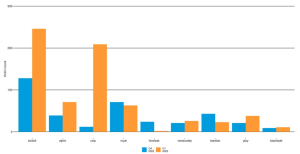Key takeaways:
- Using sprint planning templates helps agile teams organize sprints by connecting backlog items with ownership details in a shared workspace.
- Project management software provides pre-built sprint planning templates equipped with velocity charts and backlog dashboards that help teams measure delivery rates and forecast capacity for future sprints.
- Sprint planning templates improve workload accuracy by pairing story points with capacity data so teams can plan realistic sprint goals.
Agile teams often struggle to plan sprints efficiently when tasks and priorities sit in different tools. Sprint planning templates solve this by combining backlog items and team workload in one workspace, giving every contributor a shared view of goals and progress. In this article, I provide a list of free sprint planning templates and explain how to use each one effectively to help you get started.
What is a sprint planning template?
A sprint planning template is a pre-built document that guides agile teams through setting goals and defining deliverables for an upcoming sprint. They often include fields that help you manage multiple tasks across extended sprints or several sprints at once while giving you a single reference for assigned work, estimated completion times, and high-priority tasks.
Common formats include spreadsheets, Kanban-style boards, and grid-style task trackers integrated into some of the best project management software. Teams use these within agile environments, particularly in Scrum, to plan work cycles and ensure every team member understands what must be accomplished during the sprint.
Why use a sprint planning template?
If you’re still relying on scattered notes or informal discussions for your sprint planning, a sprint planning template can help you improve organization, manage time better, enhance communication, and more.
- Improved organization: Sprint planning templates solve the problem of disorganized sprint preparation by centralizing backlog items, task ownership, and capacity data in one space.
- Clear task ownership: Each member can see their responsibilities and deadlines, preventing duplicate efforts.
- Better time management: Templates help allocate workload evenly and track progress against sprint goals.
- Enhanced communication: Teams gain visibility into task status, which supports smoother coordination during meetings and reviews.
- Consistent sprint structure: Reusing a standard format promotes repeatable, predictable workflows and easier performance evaluation across multiple sprints.
What should sprint planning templates include?
A sprint plan template serves as your framework to organize team priorities and define what can be achieved within a sprint cycle. Common elements in sprint planning include your goals, backlog, and task assignments.
| Sprint goal | Defines the main objective or outcome the team aims to achieve by the end of the sprint. |
| Backlog items | List the user stories or tasks selected from the product backlog for inclusion in the sprint. |
| Task assignments | Identify who is responsible for each task, ensuring accountability and balanced workload distribution. |
| Priority level | Indicates which tasks are most critical to meeting the sprint goal. |
| Estimated effort | Provides time or story point estimates to gauge task complexity and capacity. |
| Sprint timeline | Outlines the start and end dates of the sprint along with the milestones. |
| Progress tracking | Displays task status to monitor completion and detect potential delays early. |
| Dependencies | Identify related tasks or blockers that could affect progress. |
| Review notes | Capture observations and feedback for improvement in future sprints. |
Free sprint planning templates
Spreadsheets are one way to build sprint planning templates, but this method can be time-consuming. Project management platforms offer them in multiple formats, complete with features like automation and customizable layouts.
Explore my free sprint planning templates for managing your team’s next sprint.
1. monday.com – Best for comparing sprint velocity and quality output
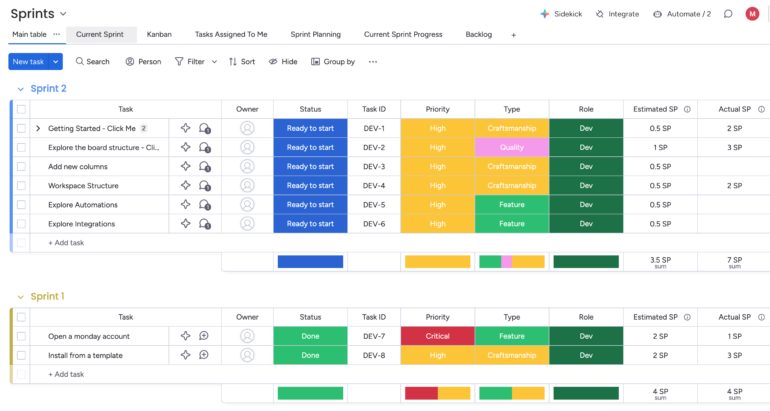
This monday.com template is perfect for teams using quantitative performance tracking across multiple sprint cycles. The story-point columns (Estimated SP/Actual SP) show estimated versus actual story points per task, which supports teams in refining capacity planning in future sprints.
Unlike Kanban-style boards that emphasize task flow, this grid format focuses on measurement and sprint outcomes. The color-coded “Priority” and “Type” columns add qualitative context while sprint grouping, role labeling, and automation promote consistency across releases.
With its detailed point tracking and customizable priorities, the template helps agile teams evaluate delivery quality and balance workloads before starting the next cycle.
2. ClickUp – Best for development cycles with mixed task types

This agile sprint planning template works best for teams managing short, consecutive sprints and want a single board that carries work across iterations.
It allows you to compare the load between the current sprint and the next one because each task card carries sprint metadata, including date ranges, story points, epic tags, and a visible sprint goal on each card. This provides immediate context for prioritization and progress checks during standups or reviews.
The “Sprint” field and “Active Sprint” view, along with the ability to group by development stage, allow tracking across the stages of pending, implementation, review, and deployment.
This focus on continuity helps teams stay aligned across sprint cycles and determine which tasks are ready for review or deployment. The template also includes folders, such as Sprint, Product, and QA, which you can customize based on your team’s meeting preferences.
3. Jira – Best for backlog management
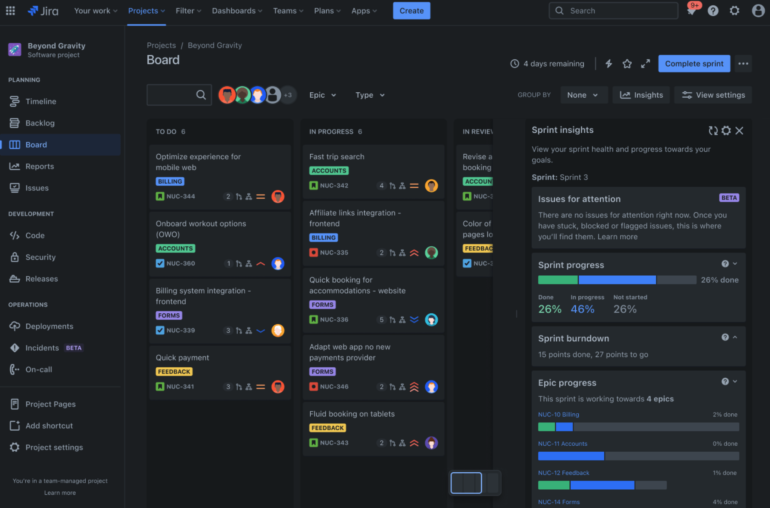
Jira’s sprint template is designed for teams managing deep backlogs that require full traceability from epics down to subtasks. It brings structure to sprint planning by connecting backlog prioritization with task tracking.
The layout has two parts: the backlog view, where teams refine and prioritize items for upcoming sprints, and the Kanban board, which visualizes task progress as work moves through each development stage.
The backlog view combines epics, ranked stories, and estimates in a single workspace where teams can drag tasks into a sprint and assess team capacity using historical velocity data. During sprint planning sessions, Scrum masters and team members can collaborate in real time to clarify story details and finalize sprint commitments.
Once the sprint begins, built-in burndown and velocity charts display progress patterns and highlight when commitments drift from capacity. Each sprint can also be linked to a specific release version, allowing teams to trace progress against long-term objectives and maintain accountability across iterations.
4. Miro – Best for collaborative planning
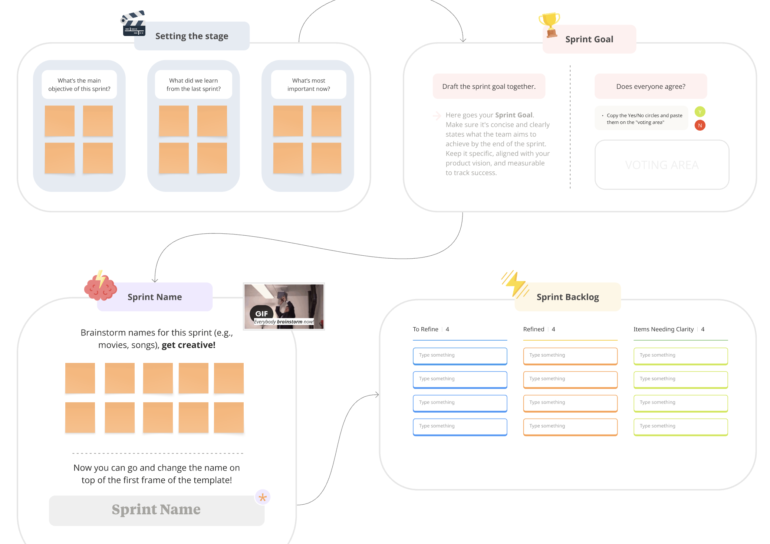
Miro’s sprint planning template works best as a collaborative workshop space where teams plan and discuss sprint goals together. Instead of treating sprint planning as a task-assignment meeting, the template uses guided sections and visual notes to help teams make collective decisions.
Each stage moves the team from reviewing inputs to confirming commitments, which builds shared understanding and eliminates confusion about priorities or ownership.
The facilitation-first layout creates a smooth, interactive flow. Built-in timers, voting tools, and color-coded notes help teams resolve competing priorities quickly without shifting to other platforms. By the end of the session, the team leaves with a clearly defined sprint goal and visible deliverables recorded on the same canvas, making it easier to maintain focus and accountability throughout the sprint.
5. Smartsheet – Best for Gantt chart-based scheduling

If you need a sprint planning template for Excel, Smartsheet offers a spreadsheet version integrated with a live Gantt chart to display sprint timelines and task dependencies.
The sheet connects each task’s start and end dates to a dynamic Gantt chart below the spreadsheet, so each change to task duration or completion status instantly adjusts the chart, giving you a clear view of how work stacks up across sprints.
This setup creates a single-sheet loop that reduces the back-and-forth between a tracker and a separate roadmap. It turns sprint planning into a continuous forecasting process and helps teams translate their sprint plans into date-based progress, allowing you to plan iterations and compare effort signals directly in the same view.
Story points and duration sit side by side, which reveals when the team assigns high complexity to a short window or low complexity to a long one, which offers early insight into capacity issues before the sprint begins.
6. Wrike – Best for custom sprint workflows
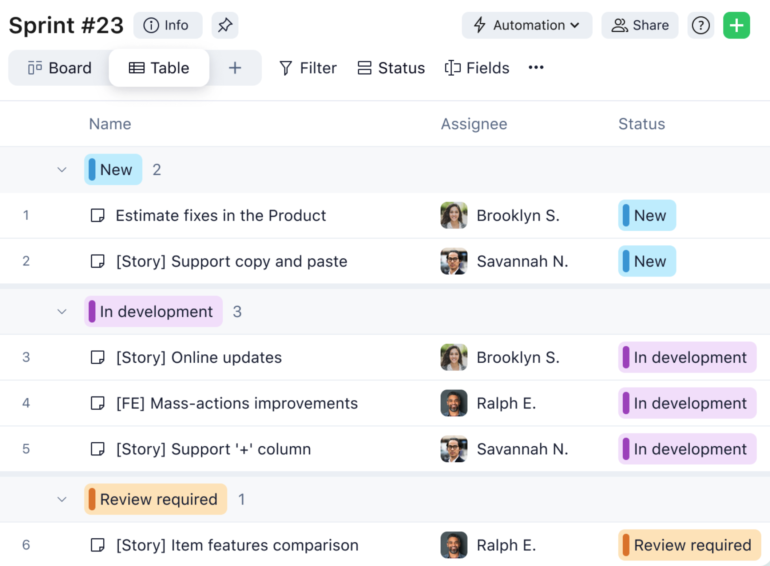
Wrike’s agile sprint planning template is best for custom sprint workflows that blend structured intake with flexible delivery. The template connects request forms, dashboards, and sprint boards so that incoming work moves through a consistent path before commitment.
Each item enters the sprint already categorized and assigned a status, so the team can focus on execution rather than sorting tasks during planning.
The table view groups tasks by custom workflow stages like New, In Development, and Review Required, which helps in tracking ownership and reviewing cycles. Dashboards highlight pending and blocked items while folders archive completed sprints for retrospective reporting.
This setup gives agile teams complete control from intake to delivery without losing visibility over what stage each task occupies or which items are ready for handoff
7. Confluence – Best for sprint planning meetings

If you need a detailed guide on how to run a sprint planning meeting, Confluence provides a specialized template that helps teams structure discussions and outline goals effectively. The template begins with a checklist where you can track the tasks completed before, during, and after the sprint planning.
Then, it organizes meeting details into separate sections such as agenda, previous sprint summary, velocity tracking, and capacity planning. These sections prompt users to review backlog updates and document follow-up actions directly within the page.
The template connects team discussions to real metrics through capacity tables, velocity tracking, and risk documentation. These sections allow teams to compare previous and current sprints and understand how much work they can commit.
Linking Jira velocity reports and adding capacity details within the same page helps the group make informed decisions about workload, dependencies, and achievable goals.
How to use a sprint planning template effectively
By now, you probably know which template fits your next sprint planning session, so it’s time to focus on using it effectively. Apply the following tips to guide your meetings.
- Set a clear sprint goal before filling in tasks. Many teams jump straight into assigning work without defining a single objective. Start by agreeing on what success looks like for the sprint so every task supports that outcome.
- Keep backlog items refined and prioritized. A cluttered backlog slows planning and confuses priorities. Review and update it regularly so that only actionable, high-value items move into the sprint.
- Estimate effort with the team. Estimating alone leads to skewed capacity planning. Discuss effort as a group to align on complexity, then record the points or time in the template for future forecasting.
- Limit the number of tasks per sprint. Overloading the sprint creates burnout and unfinished work. Use past velocity or story points to help with estimation efforts, limit tasks assigned, guide realistic load, and leave room for unforeseen issues.
- Review progress mid-sprint. Many teams wait until the end to analyze performance. If you’re running a long sprint, check the template mid-way through to catch scope creep, reassign blocked tasks, and recalibrate priorities early. I recommend Scrum masters constantly monitor shorter sprints.
- Leverage built-in reports or dashboards. Neglecting data visualization hides important trends. Use burndown charts or velocity views (if available) to identify bottlenecks and improve the next sprint cycle.
- Document sprint notes for retrospectives. Teams often skip writing observations or lessons learned. Capture these insights directly in the template to guide better estimations and decisions in future sprints.
FAQs
What is the 3-5-3 rule in Scrum?
The 3-5-3 rule refers to Scrum’s structure: three roles, five events, and three artifacts. These elements define how teams plan, execute, and deliver work in short cycles. The goal is to maintain transparency and consistent delivery through a repeatable framework that balances structure with flexibility.
How to create a sprint plan?
Creating a sprint plan is easier if you use a sprint planning template. From there, define a clear sprint goal and select backlog items that match it. Assign responsibilities, estimate effort for each task, and confirm capacity so that the workload stays realistic. Finalize timelines, identify dependencies, and confirm acceptance criteria so that the team can begin the sprint with clear expectations and measurable outcomes.
What is the best tool for sprint planning?
The best tool depends on your workflow and team size. Jira suits development teams needing detailed tracking, while monday.com and ClickUp fit teams that prefer visual task organization. Choose a platform that integrates reporting features and collaboration tools to keep planning and execution in sync.
Source of Article
